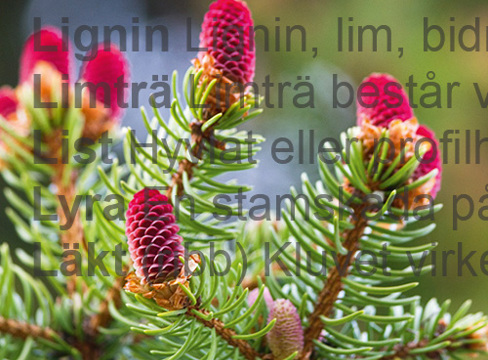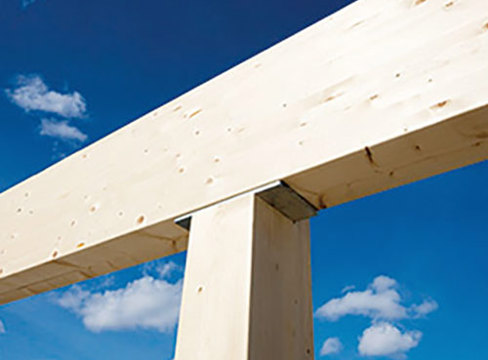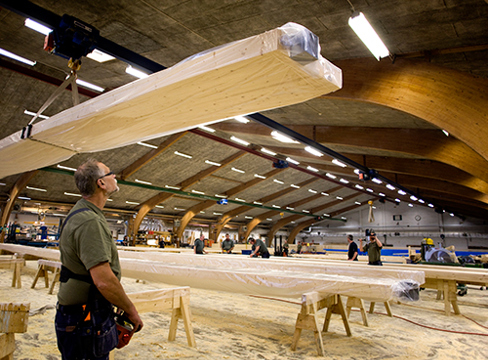Sheet materials
Wood-based sheet material is a versatile product for building and interior fittings. Panels are used for flooring, walls and roofs, for furniture and in thin sheets to give bookshelves some rigidity. Interior fittings include cupboard carcasses, cupboard doors and countertops. The panels are made from wood material in the form of staves, veneer, chips or fibre, and are manufactured to various different standards. On CE-marked construction panels, the labelling states the main purpose (floor, wall or ceiling). Table 32, page 107, presents a list of standards for wood-based sheet material.
Plywood
Plywood panels are made from an odd number of thin veneers laid at right angles to each other and glued together. The veneers are obtained by slicing or rotary cutting. Since the wood pattern is important for the final look, the method of cutting the veneer is crucial. The pattern of the grain or other characteristics of the wood raw material provide a richly varied appearance. Some types of plywood are coated with a thin surface layer of melamine or phenolic film (shuttering plywood). A pattern embossed on the paper film can give the character of different woods. Veneers with sawn knots give the surfaces a great deal of variation. For some grades, any knot-holes in the surface veneer are filled to give a smooth surface.
When using plywood, it is worth noting that the panels are usually stiffer and stronger in one direction. Its structure means that plywood can be sawn into any shape. Plywood is usually glued together with phenolic resin, which is essentially a water-resistant adhesive. Plywood can therefore be used for concrete formwork and for façades, roofs, boats and caravans.
Shuttering plywood is designed for making moulds to shape cast concrete. Both sides of the panel have a completely smooth surface veneer coated with a layer of paper impregnated with phenol (phenolic film). Shuttering plywood also has a wide range of other uses, not least in agriculture, transport and signs. An anti-slip finish can be achieved by embossing a pattern on the surface layer.
Quality and labelling of plywood
The designations B, BB and X apply to pine plywood and hardwood plywood.
B means a surface with only very small knots. Small knot-holes and splits in the veneer are filled. The surface is finely sanded.
X represents a surface that may have a considerable number of (sometimes large) knots, knot-holes and splits. BB is a grade between B and X.
Structural plywood and construction plywood are named according to ISO and European standards or to American regulations. The standards include a class E that in practice stands for surface veneers without any knots. The standards then class the surfaces using the Roman numerals I, II, III and IV.
A common quality designation for construction plywood is K20/70.
Class I has the least knots and knot holes. A total designation for both the front and back might thus be II/III. The American regulations have classes A, B, C and D (with a rising number of permissible knots). A P in the designation means that knot-holes and splits have been repaired to give a smooth surface. A total designation for both the front and back might thus be CPC.
Construction plywood may be used for load-bearing structures under Boverket’s Building Regulations (BBR). All construction plywood is CE-marked. The CE mark links back to documentation stating properties such as strength. For construction plywood in Sweden, the key point to note is how the type, structure and thickness of the plywood can be linked to the manufacturer’s performance declaration/product description. For each sheet of construction plywood, the CE label must also include the applicable product standard. The manufacturer may have their own definition of their grade (product standard) or refer to European standard SS-EN 636, which uses “-3” to denote exterior use and “S” for load-bearing function. The panel must also be marked with its nominal thickness and wood species. If, for practical reasons, it is not appropriate to place the CE mark directly on the panel, an adhesive label can be placed on the panel or on the packaging.
Particleboard
Particleboard is manufactured on a continuous production line where layers of adhesive-coated fine and coarse wood chips are layered up, pressed and hardened under pressure and heat. The fine chips give the board a surface that is suitable for painting. Since the process involves chips being scattered onto a conveyor and to some extent lining up in the direction of travel, the properties of particleboard differ slightly across its width and along its length. The most common adhesive for particleboard is carbamide adhesive (urea). Particleboard is used in areas such as subfloors, walls, ceilings, furniture and interior fittings.
It is given a designation according to its intended use, whether furniture, construction, flooring, ceilings or some other application. For historical reasons, the moisture tolerance of particleboard is divided into V20 and V313. V313 is the moisture-resistant type. The standard splits the panels into types P1 to P7, based on their intended use. Types P1 and P2 are designed for general use and for interior fittings and furniture in dry rooms. Type P3 is for the same uses but in a damper environment. Types P4 to P7 can be used for various purposes in load-bearing structures in line with Eurocode 5. Type P5, for example, can be used as the web in a lightweight beam.
Cement bonded particleboard
Cement-bonded particleboard is the result of binding the wood chips together with cement. These panels offer particularly good resistance to fire and microbial decay. Cement-bonded particleboard is described according to its intended use, colour and surface properties, plus the shape and edge-profile of the panel. The panels can be custom-made for use in wet rooms or on façades.
Melamine coated boards
The melamine layer on faced particleboard is made by pressing together and heating several layers of paper impregnated with plastic. This melamine layer becomes a very thin facing material that not only provides a hardwearing surface but can also be used for decorative effect. Melamine on particleboard is the most common combination. Moisture-related movements can vary a little between the particleboard and a melamine layer, which is why it is best that both faces of the board are coated. If only one side is coated, the board may warp. Melamine faced board is widely used for furniture and interior fittings.
OSB
OSB (Oriented Strand Board) can be recognised by the large, flat wood shavings that can be seen even on the surface of the board. The boards are particularly resistant to corner breakage. Just like plywood, OSB has a clear main orientation. The wood shavings near the surface follow the length of the board, while the shavings in the mid-section are perpendicular to the length. The shavings may be softwood or hardwood. The adhesive can be phenolic resin in powder form or melamine adhesive. OSB is used in applications such as walls and packaging.
It comes in types 1, 2, 3 and 4 as set out in the relevant standard. Type OSB/1 is designed for general use and for interior fittings in dry rooms. Type 4 is the densest and most resistant to moisture. Types OSB/2 to OSB/4 can be used for various purposes in load-bearing structures in line with Eurocode 5.
Wet process fibreboard
Wet process fibreboard (masonite) is made from fibres extracted from the wood through powerful steam processing, grinding or refining. The fibres are suspended in water and pumped out onto a wire mat, where the water drains off. Varying levels of pressure are then applied to produce boards with different properties, from soft and porous to hard. The fibres are usually held together by the adhesive substances that occur naturally in the wood, along with small quantities of phenolic resin. Hard fibreboard has a distinct smooth front, while the back retains the pattern of the wire mat, which was imprinted in the press. The board is hardened thermally, with some variants treated with oil before this stage.
The standard divides wet process fibreboard into the main types hard, medium and soft.
Dry process fibreboard
Medium density fibreboard (MDF) is a dry-processed fibreboard, made from dry, carbamide-bonded fibres. MDF is an almost entirely homogenised material with very consistent properties, for example when painted. Widely used for furniture and interior fittings, amongst other things, MDF is available with different moisture tolerances and levels of finishing, in flexible and veneered formats and with properties that meet the requirements set out in the standard.
Wood wool board
Wood wool board is made from wood wool that is bonded together with cement. Cement sets chemically with the addition of water. Wood wool consists of wood shavings that are half a metre long and a couple of millimetres wide, planed from the roundwood log. Wood wool board has particularly good sound absorption and fire resistance properties, which is why it is used for acoustic panels in ceilings or as a sound absorber in acoustic barriers. The board is an open material that allows air and moisture to pass through. Wood wool products have good environmental properties, and many are approved by independent certification bodies.
Wood wool boards are described according to their use, colour and the structure of the board’s face, e.g. ceiling, white, fine-planed.
Edge-glued panels
Edge-glued panels are a sheet material made from dried mass timber. The panels are produced by gluing together 40–45 mm wide blocks, usually of softwood, although hardwood may also be used. The adhesive is water-based. Flat, sanded and dried edge-glued panels are popular for applications such as countertops and shelves.
Blockboard
Blockboard is an edge-glued panel that is reinforced with symmetrically bonded veneer or fibreboard. For bookshelves, blockboard gives the load-bearing capacity of the edge-glued panel and the appearance and surface properties of the veneer or hard fibreboard.
Blockboard is described according to the base material (pine staves for example) and the type of surface layer (veneer, fibreboard, melamine). An example is “laminboard” which is finished with a hardwood laminate.
Multi-ply board
Multi-ply is produced in three or five layers, arranged at 90° to each other, with a thickness of 21 or 30 mm. Multi-ply is a dimensionally-stable mass timber product with a structure not unlike blockboard, and can easily be machined to make doors for kitchen and bathroom cabinets and wardrobes. It can also be used for feature tabletops and shelves. Tabletops often use multi-ply with more than five layers. The board is manufactured in various woods, including pine.
Table 32 Standards for wood-based panels
|
Standard |
Description |
|
Plywood |
The term plywood is a collective name for veneered plywood, blockboard, laminboard and composites. |
|
SS-EN 313-1:1996 Plywood – Classification and Terminology |
The standard describes different types of plywood, according to their structure and key properties such as: form, durability in use, mechanical properties, appearance, surface finish. |
|
SS-EN 635-1: Plywood – Classification by surface appearance – Part 1: General
SS-EN 635-2: Plywood – Classification by surface appearance – Part 2: Hardwood
SS-EN 635-3: Plywood – Classification by surface appearance – Part 3: Softwood |
The standards comprise five appearance classes for plywood surfaces, based on visible characteristics and defects. |
|
SS-EN 636: Plywood – Specifications |
The standard covers the classification of plywood for load-bearing and non-load-bearing structures, referring to factors such as bending strength, modulus of elasticity, formaldehyde and other properties, testing methods, manufacturing checks and labelling. The document includes a table of usage classes 1–5 and general moisture content levels. |
|
SS-EN 12369-2: Characteristic values for structural design – Part 2: Plywood |
The standard contains characteristic values for strength, modulus of elasticity and shear modulus for different classes of plywood defined in SS-EN 636, for use when designing load-bearing structures that use plywood. |
|
SS-EN 13986: Wood-based panels for use in construction – Characteristics, evaluation of conformity and marking |
The standard covers wood-based construction panels, setting out relevant characteristics and testing methods for determining these characteristics. |
|
Particleboard |
The term particleboard refers to traditional sheet material made from wood chips and adhesive. Cement-bonded particleboard and OSB, see under separate headings. |
|
SS-EN 309: Particleboards – Definition and classification |
The standard provides a definition and classification of particleboard. |
|
SS-EN 312: Particleboards – Specifications |
The standard includes requirements for particleboard as defined in SS-EN 309. |
|
SS-EN 12369-1 Wood-based panels – Characteristic values for structural design – Part 1: OSB, particleboards and fibreboards |
The standard contains characteristic values for strength, modulus of elasticity and shear modulus for different classes of OSB, particleboard and fibreboard, for use when designing load-bearing structures that use the aforementioned sheet materials. |
|
Cement-bonded particleboard |
|
|
SS-EN 633 Cement-bonded particleboards – Definition and classification |
The standard defines and presents different types of cement-bonded particleboard. |
|
SS-EN 634-1 Cement-bonded particleboards – Specifications – Part 1: General requirements |
The standard provides general requirements concerning cement-bonded particleboard, including measurement tolerances, edge straightness, right-angles and moisture content. |
|
SS-EN 634-2 Cement-bonded particleboards – Specifications – Part 2: Requirements for OPC bonded particleboards for use in dry, humid and external conditions |
The standard includes requirements concerning density, strength, stiffness, adhesive and swelling. |
|
OSB |
|
|
SS-EN 300: Oriented Strand Boards (OSB) – Definitions, classification and specifications |
The standard contains definitions, classifications and requirements. |
|
SS-EN 12369-1 Wood-based panels – Characteristic values for structural design – Part 1: OSB, particleboards and fibreboards |
The standard contains characteristic values for strength, modulus of elasticity and shear modulus for different classes of OSB, particleboard and fibreboard, for use when designing load-bearing structures that use the aforementioned sheet materials. |
|
Fibreboard |
|
|
SS-EN 316: Wood fibre boards – Definition, classification and symbols |
The standard contains definitions, classifications and symbols, for example relating to wet-processed and dry-processed fibreboard. Wet-processed fibreboard is in turn split into hard (HB), medium (MBL or MBH) and soft (SB). Dry-processed fibreboard is called MDF (= Medium Density Fibreboard). |
|
SS-EN 622-1 Fibreboards – Specifications – Part 1: General requirements |
The standard sets out general requirements for certain properties that are common in non-coated fibreboard. |
|
SS-EN 622-2: Fibreboards – Specifications – Part 2: Requirements for hardboards |
The standard contains requirements for hardboards. The values in the standard relate to product properties but are not characteristic values intended for strength-dimensioning in line with Eurocode 5. Those values are presented in SS-EN 12369-1. |
|
SS-EN 622-3: Fibreboards – Specifications – Part 3: Requirements for medium boards |
The standard contains requirements for medium fibreboards. |
|
SS-EN 622-4: Fibreboards – Specifications – Part 4: Requirements for soft boards |
The standard contains requirements for soft fibreboards. |
|
SS-EN 622-5: Fibreboards – Specifications – Part 5: Requirements for dry process boards (MDF) |
The standard contains requirements for MDF. The values in the standard relate to product properties but are not characteristic values intended for strength-dimensioning in line with Eurocode 5. Those values are presented in SS-EN 12369-1. |
|
SS-EN 12369-1 Wood-based panels – Characteristic values for structural design – Part 1: OSB, particleboards and fibreboards |
The standard contains characteristic values for strength, modulus of elasticity and shear modulus for different classes of OSB, particleboard and fibreboard, for use when designing load-bearing structures that use wood-based sheet materials. |
|
Wood wool products |
|
|
SS-EN 13168: Thermal insulation products for buildings – Factory made wood wool (WW) products – Specification |
The standard contains requirements concerning factory made wood wool products in the form of sheets or panels, with or without a cladding or surface layer, intended for thermal insulation in buildings. |














